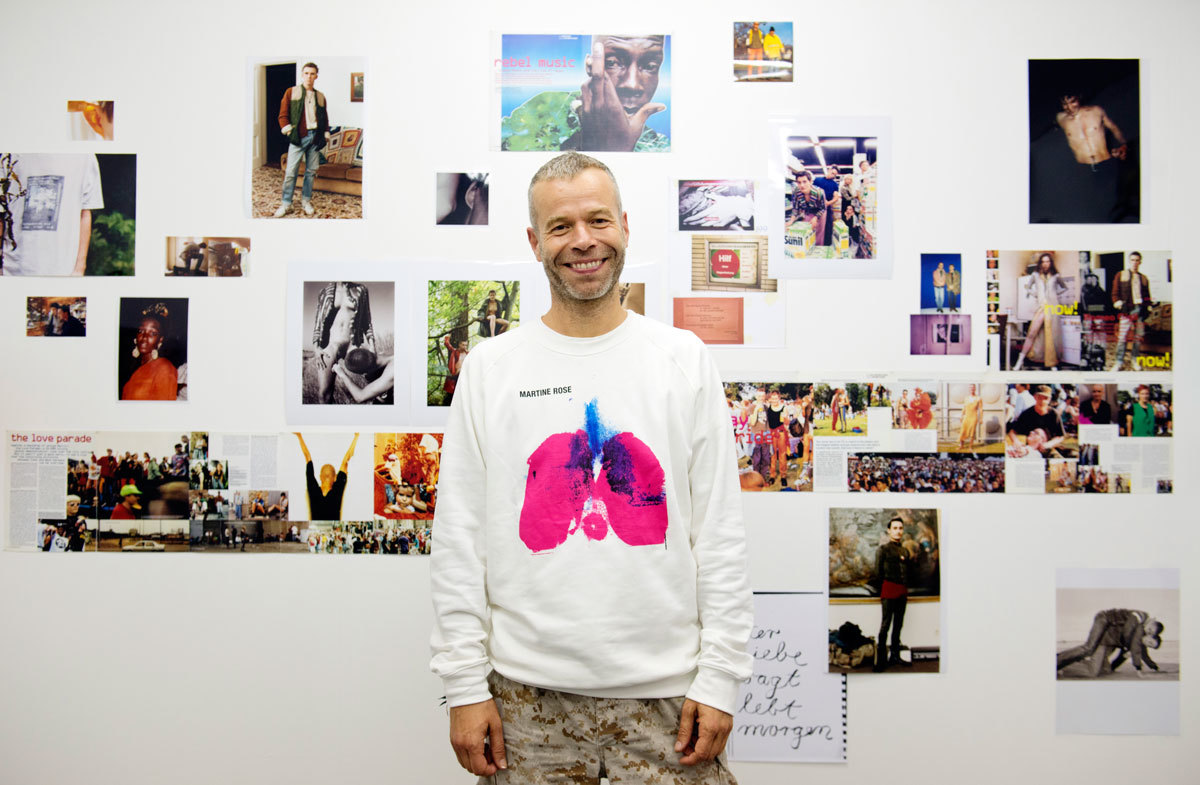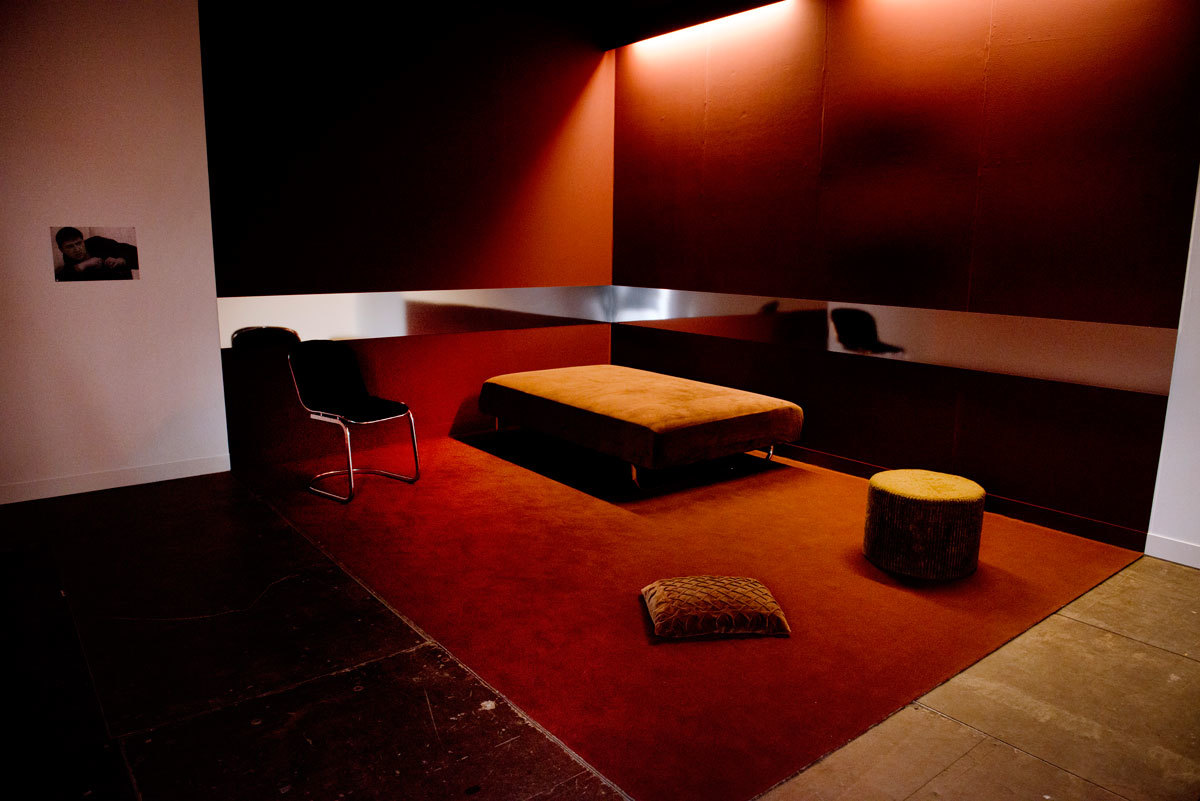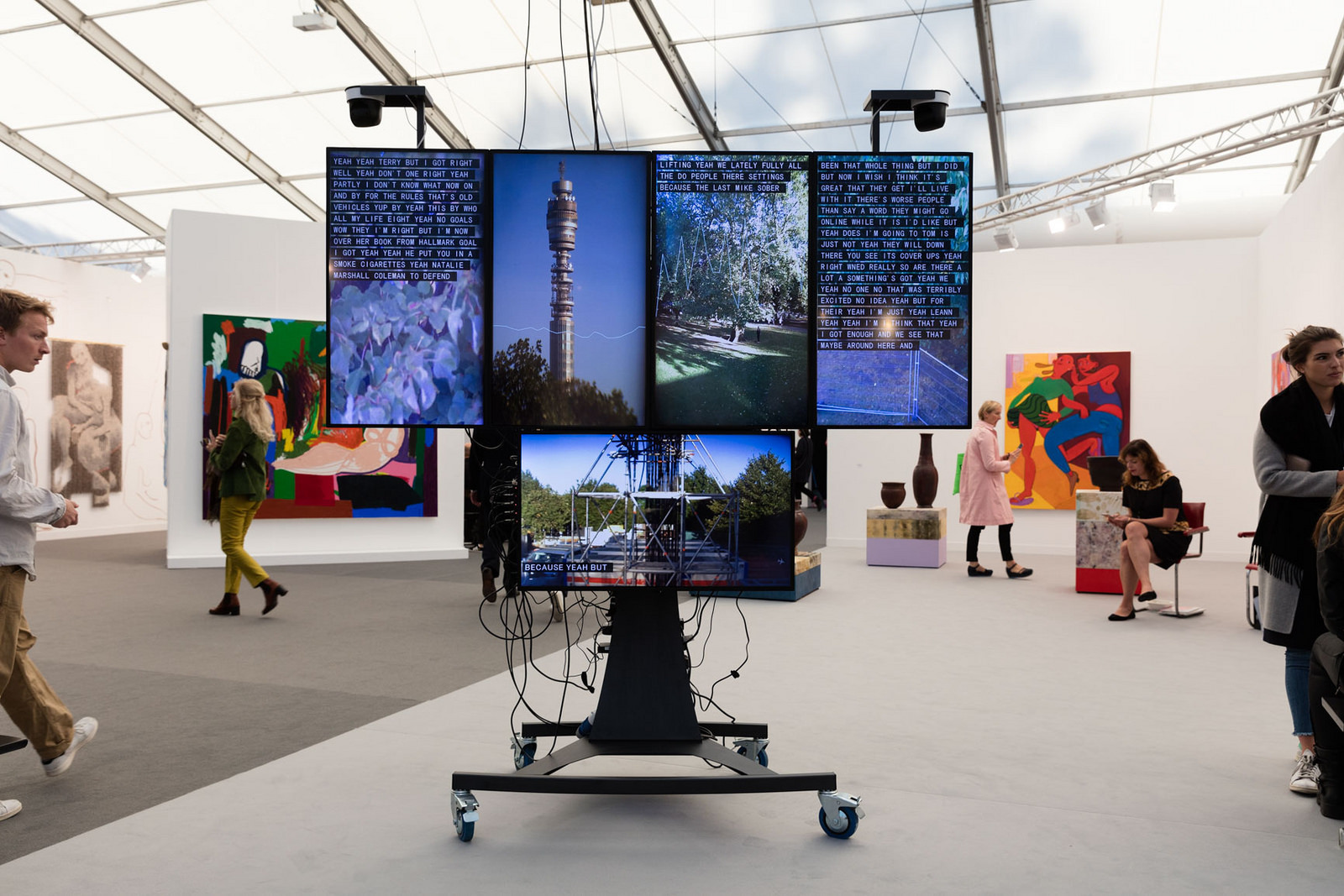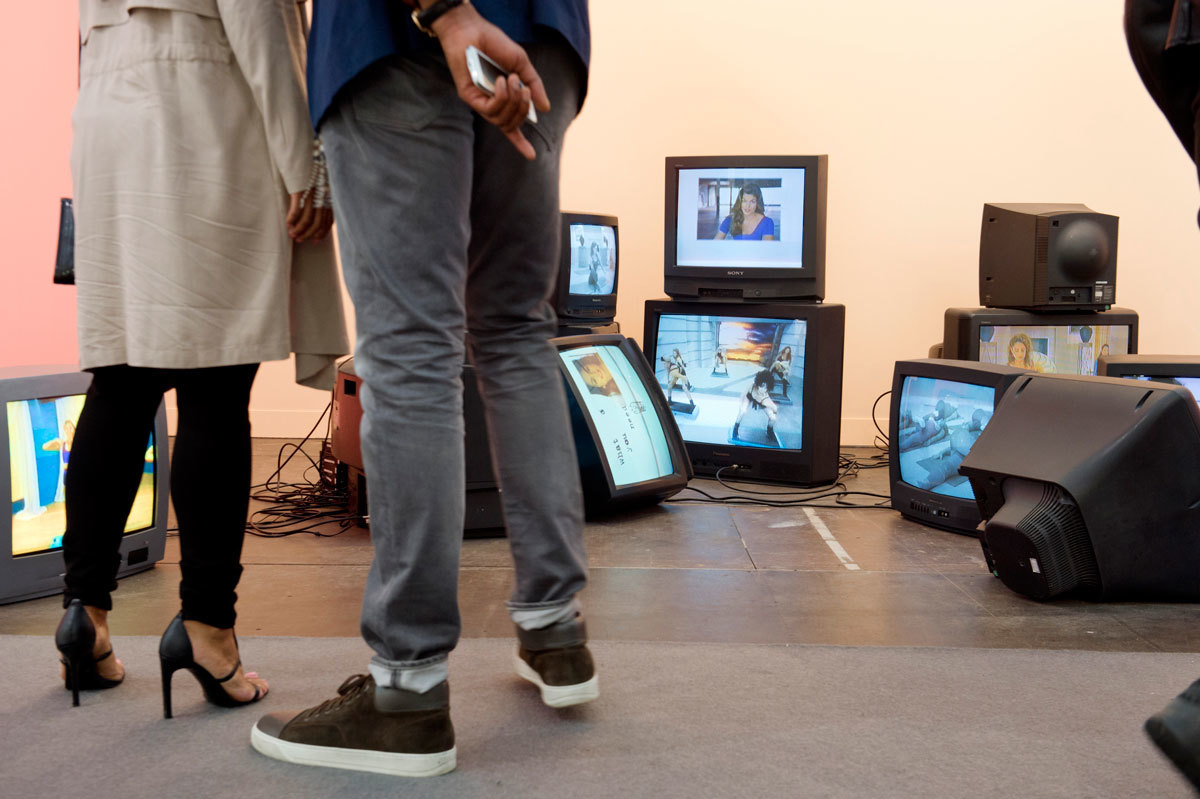For its 14th edition (and the company’s 25th anniversary) Frieze London presented new section at the fair this year, The Nineties, curated by Nicolas Tremblay, offering 14 galleries (including long-closed era-defining spaces) the chance to re-stage influential shows from the eponymous decade. Tremblay’s selection offers a subjective insight into the decade whose political and cultural legacy has left an indelible mark on the artists, gallerists and dealers of today. But why now? And who is it for?
Frieze itself was founded in London in the 90s, first as a magazine, before growing to include an art fair and a foundation in 2003, evolving to another fair in New York, a second one in London, four publications and most recently, an academy. The original fair in London has become an art world behemoth that brings millions of pounds, several hundred works of art and over a hundred thousand bodies together to slide around on the same slippery stage; a trade show dressed as public spectacle and a buying frenzy for the super wealthy.
But while the organisers love to peddle the idea that the fair exists to wedge contemporary art deeper into a receptive public’s imagination – against all evidence that it’s an industry souk – they’re secretive about expansion plans. The media company signed a deal with a gargantuan Hollywood talent agency (WME-IMG) earlier this year and founders Matthew Slotover and Amanda Sharp have made comments that suggest they have their eyes on expanding their market into digital services like those of Paddle8 or Artsy, or even potentially dabbling in virtual reality.

This year’s press release calls the new Nineties section “pioneering” which makes me wonder what they have in store for next year. Is the platform going didactic as well as digital? Wandering around the new section it certainly felt that way, with A4 handouts offered at each booth in wall mounted trays in addition to the gallery hands on deck. I wonder if the new section is a hedge against the volatility of recent market fads like the short-lived vogue for abstract painting, a psychological wink at the potential for finding and buying a work elsewhere in the fair with the prospect of being canonised later.
As I’m pondering, I wander into a literal hedge. Karen Kilimnik’s Fountain of Youth (cleanliness is next to godliness) installation is manned by a gallery representative who looks like she could sit for one of artist’s delicate paintings, or live permanently in the groomed formal garden that dominates the booth. Petite and angular and somewhat crumpled by the third day of the fair when I find her crouching over her laptop behind a large false shrub, she patiently recounts details about the work that I will later read in the A4 handout I have stuffed into a pocket. When I ask her why the work is important she tells me the original was one of Kilimnik’s earliest shows. She adds that the original 1992 work was a garden in miniature, but the one at Frieze is modelled after a larger life-size version at a solo show held at the prestigious Brant Foundation in 2012. I leave wondering if the purchase of Kilimnik’s work by celebrity collectors does make it important, or if I need to change my definition of the word in the context of a commercial environment. The art fair isn’t an art museum after all, and notions of importance can be bundled and sold along with the works themselves.
Two more of the new section’s booths presented pivotal shows for the decade’s photographers, Wolfgang Tillmans’ first show, with Buchholz in Cologne in 1993, and Richard Billingham’s 1996 exhibition of family portraits, Rays’s A Laugh, shot on a cheap instamatic in 35mm. Curator Nicolas Tremblay has been vocal about his rejection of nostalgia-tinged choices in his curation process, but it’s difficult to look at any moment captured in celluloid without hearing a doleful note. It’s also telling that the two photographers included are both known by their unflinchingly raw documentary style, so characteristic of the grungey era-defining aesthetic we know and love the nineties for.

The Buchholz trading post is a squash at 3 metres squared, to match the scale of the original show with a low ceiling and cheap standard flush door leading nowhere. Mild claustrophobia makes for a surreal experience within a monstrous tent inside Regents Park. But it’s also somewhat apt in 2016, to feel a little boxed in with these old photographs of beautiful young androgynous men and women now that identity politics has made an urgent return to public discourse. A series of potently tight square crops of clubbers at long-closed Kentish Town techno haunt, Chemistry, face more familiar florid scenes of youth culture and street style, some torn from the pages of i-D’s own print magazine. To those actually born in the 90s I imagine it might look like a very primitive Instagram feed. Tillmans’ best known (most liked?) image, a photo Lutz and Alex sitting in trees, is there too. The entire booth is already on reserve to a German museum as a single work.
Another enclosed space is Dominique Gonzalez-Foerster’s R.W.F. (1993) presented by Esther Schipper. The original staging transformed an entire Cologne apartment into a fictional film set, whereas the booth at Frieze offers only one room for the French artist to motion towards the emotional climate of Rainer Werner Fassbinder’s films. Like the Buchholz booth, it’s inclusion is surely to illustrate the improvised, experimental nature of the decade and offers stark and severe respite to the bustling present outside. It was tempting to sink into the modernist furniture or crawl onto the soft carpet but by the third day of Frieze there were huffy A4 signs tacked to the floor forbidding visitors from becoming too much a part of the art, despite this being a big part of Gozalez-Foerster’s work. Back to life, back to reality.

So why start with the 90s? For one thing, they never really ended. As political theorist Francis Fukyama would have it, only history did, his argument being that 1989 marked the end of a battle of ideologies and the inevitable triumph of a liberal capitalist democracy. In the year that gave us Brexit and Trump, we know that ideological conflict is far from over, is ever more sophisticated, and that the world is as divided as ever. The difference is that that now we all have the opportunity to voice dissent, or offer solutions on social media platforms, instantly and without pause to consider whether this might actually be dividing us further.
The 90s did see a comparable period of massive social and political upheaval, but then, so did the 00s, and the 10s aren’t pulling any punches either. Specifically, the art stars of today will remember the 90s for the rise of globalisation and digital communication, the first Gulf War, the AIDS crisis, the poll tax riots, political debauchery, the birth of reality television culture and the demise of privacy, as well as German reunification, terrorist attacks everywhere and innovations in computing and medical science. Broadly, it’s a landscape that’s easy to compare to today’s, and that seemed to be the focus of a panel discussion held at the fair on the Friday with several artists who have witnessed both first hand: Wolfgang Tillmans, Adrian Searle, Julia Peyton Jones and Jane and Louise Wilson.
The discussion see-sawed back and forth between then and now, with a focus on changes in technology (What ever happened to fax art? “It faded”, quipped a Wilson) and a misty-eyed look back at art education and social scenes in New York, Berlin and London. Adrian Searle traced the market-driven climate of today to an “opening-up” of art and it’s markets internationally thanks to developments in communication and cheap airfare. As all of the panellists were keen to point out, the same themes that captured artists 25 years ago are at the fore of the discourse again today: the meaning and construction of identity, technological progress, economic turmoil, political disarray, the threat of war. But although the subjects of Brexit and Trump were addressed, no one on the panel had any solutions to the political schism except Tillmans, who urged the audience to remember that the 48% who voted remain did not have to stay silent about the costs of leaving the European Union, both financial and human.

The 90s began with a recession and so did our own decade. But where the reaction to the economic trouble in 1991 gave way to the period of rethinking and a sense of DIY optimism in the art world that gave us reactive movements like relational aesthetics and grunge, the 2008 financial crisis gave us low-overhead, vapid zombie formalism, which risk-averse galleries were thrilled to push until a recent sag in demand. Wandering along the aisles of the Focus and Main sections of the fair I noticed walls notably bereft of those dreary New Abstraction bro paintings, replaced instead by a wave of muddily florid canvases by artists like Torey Thornton, Celia Hempton and Ryan Mosley. Bold and sombre work by younger artists sang out, like Jesse Darling’s March of the Valedictorians at Arcadia Missa, Darja Bajagić’s Molly wallworks at Carlos/Ishikawa and Yuri Pattison’s wonderful Frieze Artist Award commissioned project, Insights (Crisis Trolley), which provides a beautifully succinct critique of the context in which it is shown.
I entered the fair suspicious that this new Nineties section might be a cynical ploy from fair organisers looking to canonise a decade in the hope that it might galvanise young artists, these voices (sorry, content producers) of a new generation in peril, into making era-defining works that will sell well next year, or support their new ‘Academy’ platform (which offers talks like ‘Social Media for Art and Fashion’ at £149 a ticket). As much as I might enjoy looking at work made 25 years ago, I was also anxious that the trend for nostalgia driven by the internet has contributed to the rise of populism fuelling violent alt-right tendencies within Europe and America and that ultimately artists today should be looking forward, not backwards. I left feeling no less anxious or suspicious. And maybe that’s a good thing?
Credits
Text Ella Plevin
Photography Linda Nylind. Courtesy of Linda Nylind/Frieze.
